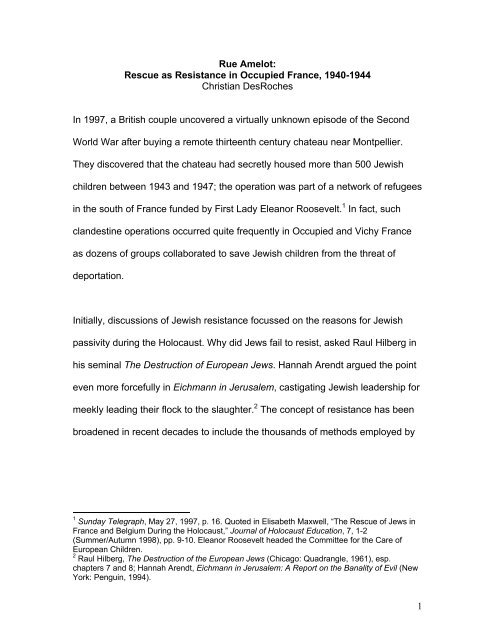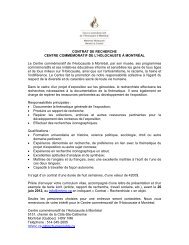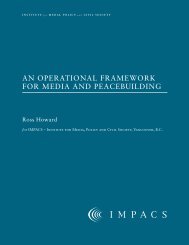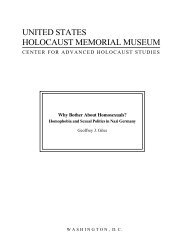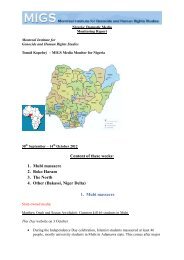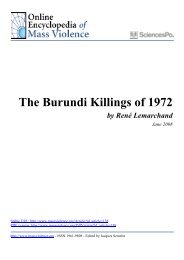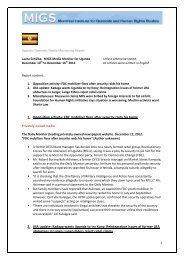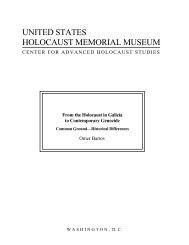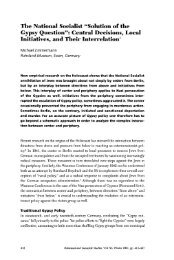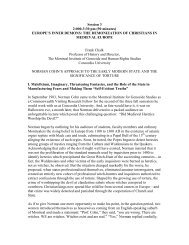a PDF version of the paper - Montreal Institute of Genocide and ...
a PDF version of the paper - Montreal Institute of Genocide and ...
a PDF version of the paper - Montreal Institute of Genocide and ...
Create successful ePaper yourself
Turn your PDF publications into a flip-book with our unique Google optimized e-Paper software.
Rue Amelot:<br />
Rescue as Resistance in Occupied France, 1940-1944<br />
Christian DesRoches<br />
In 1997, a British couple uncovered a virtually unknown episode <strong>of</strong> <strong>the</strong> Second<br />
World War after buying a remote thirteenth century chateau near Montpellier.<br />
They discovered that <strong>the</strong> chateau had secretly housed more than 500 Jewish<br />
children between 1943 <strong>and</strong> 1947; <strong>the</strong> operation was part <strong>of</strong> a network <strong>of</strong> refugees<br />
in <strong>the</strong> south <strong>of</strong> France funded by First Lady Eleanor Roosevelt. 1 In fact, such<br />
cl<strong>and</strong>estine operations occurred quite frequently in Occupied <strong>and</strong> Vichy France<br />
as dozens <strong>of</strong> groups collaborated to save Jewish children from <strong>the</strong> threat <strong>of</strong><br />
deportation.<br />
Initially, discussions <strong>of</strong> Jewish resistance focussed on <strong>the</strong> reasons for Jewish<br />
passivity during <strong>the</strong> Holocaust. Why did Jews fail to resist, asked Raul Hilberg in<br />
his seminal The Destruction <strong>of</strong> European Jews. Hannah Arendt argued <strong>the</strong> point<br />
even more forcefully in Eichmann in Jerusalem, castigating Jewish leadership for<br />
meekly leading <strong>the</strong>ir flock to <strong>the</strong> slaughter. 2 The concept <strong>of</strong> resistance has been<br />
broadened in recent decades to include <strong>the</strong> thous<strong>and</strong>s <strong>of</strong> methods employed by<br />
1 Sunday Telegraph, May 27, 1997, p. 16. Quoted in Elisabeth Maxwell, “The Rescue <strong>of</strong> Jews in<br />
France <strong>and</strong> Belgium During <strong>the</strong> Holocaust,” Journal <strong>of</strong> Holocaust Education, 7, 1-2<br />
(Summer/Autumn 1998), pp. 9-10. Eleanor Roosevelt headed <strong>the</strong> Committee for <strong>the</strong> Care <strong>of</strong><br />
European Children.<br />
2 Raul Hilberg, The Destruction <strong>of</strong> <strong>the</strong> European Jews (Chicago: Quadrangle, 1961), esp.<br />
chapters 7 <strong>and</strong> 8; Hannah Arendt, Eichmann in Jerusalem: A Report on <strong>the</strong> Banality <strong>of</strong> Evil (New<br />
York: Penguin, 1994).<br />
1
Jews to stay alive under Nazi rule, <strong>and</strong> <strong>the</strong> maintenance <strong>of</strong> Jewish life in all its<br />
religious <strong>and</strong> cultural manifestations. 3<br />
The dilemma <strong>of</strong> resistance for <strong>the</strong> foreign Jews <strong>of</strong> Paris, as we shall see, was<br />
between two options: armed resistance, or saving civilian lives. The organized<br />
rescue <strong>of</strong> Jewish children represents a unique aspect <strong>of</strong> <strong>the</strong> Holocaust in France.<br />
For while 27 percent <strong>of</strong> <strong>the</strong> roughly 300,000 Jewish adults in France perished<br />
during <strong>the</strong> Holocaust, <strong>the</strong> Final Solution only claimed 14% <strong>of</strong> Jewish children <strong>and</strong><br />
teenagers. The 10,000 children who were saved by <strong>the</strong> Jewish resistance explain<br />
this gap. 4 The widespread activities <strong>of</strong> several Jewish <strong>and</strong> Christian groups laid<br />
<strong>the</strong> groundwork for this peculiarity <strong>of</strong> French Holocaust history, not only in Paris,<br />
but also across most <strong>of</strong> <strong>the</strong> country,<br />
Ano<strong>the</strong>r case <strong>of</strong> French “exceptionalism” during <strong>the</strong> Holocaust concerns <strong>the</strong> fate<br />
<strong>of</strong> Jews <strong>the</strong>mselves as a whole. While Vichy’s collaboration with <strong>the</strong> Nazis in <strong>the</strong><br />
implementation <strong>of</strong> <strong>the</strong> Final Solution was conveniently swept under <strong>the</strong> rug in <strong>the</strong><br />
immediate postwar years amid claims that it served as a “shield” to protect Jews,<br />
this argument no longer st<strong>and</strong>s up to scrutiny. It may be true that <strong>the</strong> death toll in<br />
France was comparably low compared to o<strong>the</strong>r Western European nations under<br />
Nazi rule; yet it should not be forgotten that among <strong>the</strong> unoccupied, autonomous,<br />
3 Renée Poznanski, “Reflections on Jewish Resistance <strong>and</strong> Jewish Resistants in France,” Jewish<br />
Social Studies, 2, 1 (1995), p. 127; François Bédarida, “Préface,” in Adam Rayski, Le choix des<br />
Juifs à Vichy: Entre soumission et résistance (Paris: La Découverte, 1992), pp. iv-v.<br />
4 Lucien Lazare, “Aperçus sur les organisations juives de sauvetage,” Monde juif, 152 (Sept.-Dec.<br />
1994), pp. 21-27; Maxwell, “Rescue,” p. 3. 24 percent <strong>of</strong> a total Jewish population <strong>of</strong> 330,000<br />
perished in <strong>the</strong> Holocaust in France. See Susan Zuccotti, The Holocaust, <strong>the</strong> French, <strong>and</strong> <strong>the</strong><br />
Jews (New York: Basic Books, 1993), p. 3<br />
2
<strong>and</strong> semiautonomous allies <strong>of</strong> <strong>the</strong> Third Reich, only <strong>the</strong> French <strong>and</strong> <strong>the</strong> Slovaks<br />
delivered Jews from <strong>the</strong>ir established heartl<strong>and</strong>s to <strong>the</strong> Nazis. 5 Only 3 percent <strong>of</strong><br />
<strong>the</strong> 75,721 Jews who were deported from France returned, compared to 59<br />
percent <strong>of</strong> <strong>the</strong> 63,085 non-Jewish deportees, consisting <strong>of</strong> resistants, hostages,<br />
<strong>and</strong> political or criminal prisoners. 6<br />
Following <strong>the</strong> abrupt end to <strong>the</strong> “phoney war,” <strong>the</strong> French signed an armistice at<br />
Compiègne on June 22. Of all <strong>the</strong> countries occupied by <strong>the</strong> Nazi regime, France<br />
was unique, for in that country <strong>the</strong> Germans established both a military<br />
occupation <strong>and</strong> permitted an autonomous government with a wide degree <strong>of</strong><br />
independence. A demarcation line separated <strong>the</strong> nor<strong>the</strong>rn part <strong>of</strong> France, three<br />
fifths <strong>of</strong> <strong>the</strong> country <strong>and</strong> its richest <strong>and</strong> most strategically important part, where a<br />
military governor, General Otto von Stülpnagel, held authority as <strong>the</strong><br />
Militärbefehlshaber in Frankreich (MBF). But <strong>the</strong> French government, now based<br />
in <strong>the</strong> provincial town <strong>of</strong> Vichy, was <strong>the</strong>oretically responsible for <strong>the</strong> whole <strong>of</strong><br />
France, even <strong>the</strong> Occupied Zone – as long as its decision did not contradict<br />
those <strong>of</strong> <strong>the</strong> Germans. 7 This arrangement lasted until November 1942 when, in<br />
response to <strong>the</strong> Allied l<strong>and</strong>ing in North Africa, Germany <strong>and</strong> Italy both occupied<br />
<strong>the</strong> sou<strong>the</strong>rn part <strong>of</strong> France.<br />
5 Zuccotti, The Holocaust, p. 135.<br />
6 Poznanski, “Reflections,” p. 131.<br />
7 Michael R. Marrus <strong>and</strong> Robert O. Paxton, “The Nazis <strong>and</strong> <strong>the</strong> Jews in Occupied Western<br />
Europe, 1940-1944,” Journal <strong>of</strong> Modern History, 54, 4 (Dec. 1982), p. 691.<br />
3
The features <strong>of</strong> Maréchal Philippe Pétain’s national restoration program did not<br />
surprise those who were aware to <strong>the</strong> Vichy leader’s traditionalist views:<br />
administrative purges, outlawing <strong>of</strong> free masonry, punishment <strong>of</strong> those<br />
responsible for defeat, repression <strong>of</strong> <strong>the</strong> Communists <strong>and</strong> Gaullists,<br />
denaturalization <strong>of</strong> certain French citizens, <strong>and</strong> <strong>the</strong> establishment <strong>of</strong> a Statut des<br />
Juifs, an anti-Jewish code. 8 Pétain, like many French citizens, was disturbed by<br />
<strong>the</strong> massive influx <strong>of</strong> East European Jewish immigration in <strong>the</strong> previous decade<br />
<strong>and</strong> was convinced <strong>of</strong> <strong>the</strong> existence <strong>of</strong> a “Jewish Question.” While he accepted<br />
<strong>the</strong> presence <strong>of</strong> <strong>the</strong> established French Jews – indeed, many <strong>of</strong> <strong>the</strong>m had fought<br />
bravely for France in 1914-1918 – he cared little for <strong>the</strong> several thous<strong>and</strong> Jews<br />
that had immigrated to France in <strong>the</strong> 1930s. 9 Within a few months after Vichy’s<br />
signing <strong>of</strong> <strong>the</strong> armistice, one <strong>of</strong> Pétain’s chief cabinet <strong>of</strong>ficers would even brag<br />
“France is <strong>the</strong> only country which, along with Germany, persecutes <strong>the</strong> Jews <strong>the</strong><br />
most.” 10<br />
Sociologically speaking, it would be erroneous to speak <strong>of</strong> a unified Jewish<br />
community in France on <strong>the</strong> eve <strong>of</strong> <strong>the</strong> war. Indeed, French Jewry in 1939 was a<br />
heterogeneous, multifaceted group that boasted numerous ideological viewpoints<br />
<strong>and</strong> cultural traditions. The first dividing line was <strong>the</strong> rift between “French Jews”<br />
or “Israélites,” assimilated Jews who had long held French citizenship, <strong>and</strong> <strong>the</strong><br />
“immigrant Jews,” those who had established <strong>the</strong>mselves in France in <strong>the</strong> past<br />
decades. For <strong>the</strong> most part, <strong>the</strong>y were Polish, Rumanian, Hungarian, Russian,<br />
8 Philippe Burrin La France à l’heure allem<strong>and</strong>e, 1940-1944 (Paris: Seuil, 1995), p. 22.<br />
9 Ibid., pp. 139-141.<br />
4
Czech <strong>and</strong> Baltic state Jews, who were joined in <strong>the</strong> 1930s by German <strong>and</strong><br />
Austrian Jews who were fleeing Nazism. These immigrants were <strong>of</strong>ten close to<br />
Jewish traditions, spoke Yiddish <strong>and</strong> many brought with <strong>the</strong>m revolutionary<br />
political ideas. The Israélites, on <strong>the</strong> o<strong>the</strong>r h<strong>and</strong>, lived an assimilated, virtually<br />
secularized existence. Their distaste for <strong>the</strong>ir new coreligionists was well<br />
summarized by <strong>the</strong> Great Rabbi <strong>of</strong> Nancy, who dismissed Yiddish as “jargon.” 11<br />
This seemingly ethnic division also betrayed a basic division <strong>of</strong> class, as most<br />
French Jews were bourgeois while <strong>the</strong> immigrants were more <strong>of</strong>ten than not<br />
artisans <strong>and</strong> manual labourers.<br />
More importantly, <strong>the</strong>re was widespread concern among French Jewish circles<br />
that <strong>the</strong> massive influx <strong>of</strong> foreign Jews would lead to a new wave <strong>of</strong> anti-<br />
Semitism, a fear that was at least partly justified. By <strong>the</strong> end <strong>of</strong> <strong>the</strong> 1930s, <strong>the</strong><br />
nation’s problems coupled with a xenophobic response to immigration<br />
contributed to an atmosphere that rekindled old anti-Semitic demons. Many<br />
French Jews looked with an weary eye to <strong>the</strong> incoming East European Jews,<br />
perceiving a threat for <strong>the</strong>ir own status.<br />
There has been considerable historiographical debate over <strong>the</strong> extent to which<br />
French Jewry was actually divided at <strong>the</strong> eve <strong>of</strong> <strong>the</strong> Second Word War.<br />
Historians such as David Weinberg, Richard Cohen <strong>and</strong> Susan Zuccotti have<br />
10 Rayski, Le choix des Juifs, p. 7.<br />
11 Jean-Pierra Azéma <strong>and</strong> François Bédarida, eds., La France des années noires, vol. 2: De<br />
l’Occupation à la Libération (Paris: Seuil, 1993), p. 132.<br />
5
emphasized <strong>the</strong> chasm between <strong>the</strong> French Jews <strong>and</strong> <strong>the</strong> immigrant Jews 12 The<br />
existence <strong>of</strong> an antagonistic relationship is certainly evident in <strong>the</strong> writings <strong>of</strong><br />
many foreign Jewish activists <strong>of</strong> <strong>the</strong> time, such as poet, Communist <strong>and</strong><br />
Resistance fighter David Knout, who condemned <strong>the</strong> cautious liberalism <strong>and</strong><br />
elitism <strong>of</strong> <strong>the</strong> native “Happy Jews,” who quietly marched to <strong>the</strong>ir deaths while<br />
condemning <strong>the</strong> disruptive “isms” brought by <strong>the</strong> newcomers. 13 O<strong>the</strong>r scholars<br />
have suggested that this division has been exaggerated, including Hillel J. Kieval<br />
<strong>and</strong>, more recently, French historian André Kaspi, who has argued that <strong>the</strong> myth<br />
<strong>of</strong> an unbridgeable abyss between <strong>the</strong> two communities has been mostly<br />
embraced by North American historians who have, in his opinion, unduly<br />
stressed <strong>the</strong> differences between foreign <strong>and</strong> native Jews <strong>and</strong> failed to notice<br />
points <strong>of</strong> convergence between <strong>the</strong>se two communities. 14<br />
Never<strong>the</strong>less, regardless <strong>of</strong> divisions within <strong>the</strong> Jewish community, it cannot be<br />
denied that Vichy saw a distinction between French <strong>and</strong> foreign-born Jews.<br />
Between <strong>the</strong> regime’s traditional anti-Semitism <strong>and</strong> government leader Pierre<br />
Laval’s willingness to forsake France’s immigrant Jews to bargain with <strong>the</strong> Nazis,<br />
France’s foreign Jews would have a difficult road ahead under Vichy. While <strong>the</strong><br />
12 David Weinberg, A Community on Trial: The Jews <strong>of</strong> Paris in <strong>the</strong> 1930s (Chicago: University <strong>of</strong><br />
Chicago Press, 1977); Richard Cohen, The Burden <strong>of</strong> Conscience: French Jewish Leadership<br />
during <strong>the</strong> Holocaust (Bloomington <strong>and</strong> Indiana: Indiana University Press, 1987), p. 11; Susan<br />
Zuccotti even maintains that “[t]he mutual antipathy between French <strong>and</strong> immigrant Jews was<br />
longst<strong>and</strong>ing.” Zuccotti, The Holocaust, p. 21.<br />
13 David Knout, Contribution à l’histoire de la Résistance juive en France, 1940-1944 (Paris:<br />
Éditions du Centre, 1944), pp. 16-17.<br />
14 Hillel J. Kieval, “Legality <strong>and</strong> Resistance in Vichy France: The Rescue <strong>of</strong> Jewish Children,”<br />
Proceedings <strong>of</strong> <strong>the</strong> American Philosophical Society, 124, 5 (Oct. 1980), p. 341; André Kaspi, Les<br />
Juifs pendant l’Occupation (Paris: Seuil, 1991), pp. 17-18, 51. Kaspi does acknowledge, however,<br />
<strong>the</strong> existence <strong>of</strong> something akin to a “Mayflower complex” (Philippe Erlanger’s coined <strong>the</strong><br />
6
general death rate for <strong>the</strong> general Jewish population during <strong>the</strong> Holocaust in<br />
France is most widely considered to be 24%, <strong>the</strong> death rate among <strong>the</strong> 135,000<br />
foreign Jews reached between 41 <strong>and</strong> 45 percent. 15<br />
In <strong>the</strong> face <strong>of</strong> tragedy, French <strong>and</strong> foreign Jews reacted differently. Many chose<br />
armed resistance; some, such as historian March Bloch, chose to fight as French<br />
Resistance fighters; o<strong>the</strong>rs chose to fight as Jews. Many more still chose <strong>the</strong><br />
path <strong>of</strong> non-violent resistance, trying to find ways to hamper Nazi policy. Almost<br />
immediately after <strong>the</strong> Occupation, <strong>the</strong> plight <strong>of</strong> Jews in France became a matter<br />
<strong>of</strong> concern for many organized relief groups in France, as <strong>the</strong>y became subjected<br />
to discriminatory laws <strong>and</strong> repressive policies. A large network <strong>of</strong> organizations<br />
which included Catholic, Protestant, Eastern Orthodox <strong>and</strong> Quaker groups, as<br />
well as <strong>the</strong> YMCA, Secours Suisse <strong>and</strong> <strong>the</strong> Réseau Dutch-Paris, acted in<br />
different <strong>the</strong>atres across France, <strong>of</strong>ten unaware <strong>of</strong> what o<strong>the</strong>r groups were trying<br />
to achieve. 16<br />
In Paris, one such group was <strong>the</strong> Comité de la Rue Amelot, or Rue Amelot, a<br />
small Jewish relief organization that started providing services to <strong>the</strong> foreign<br />
Jews in <strong>the</strong> immediate aftermath <strong>of</strong> <strong>the</strong> Occupation, serving hot meals, providing<br />
medical care <strong>and</strong> supplying financial assistance for <strong>the</strong> needy. Yet as <strong>the</strong><br />
expression) among long-established French Jews, who <strong>of</strong>ten perceived <strong>the</strong>mselves as <strong>the</strong> “true”<br />
French <strong>of</strong> <strong>the</strong> Jewish community.<br />
15 Zuccotti, The Holocaust, p. 3. These figures appear to be <strong>the</strong> most widely shared estimate.<br />
Jeremy Josephs, citing figures supplied by Nazi-hunter Serge Klarsfeld, estimates that <strong>the</strong><br />
percentage <strong>of</strong> foreign French Jews killed is closer to 85%, but <strong>the</strong> evidentiary base is flimsy. See<br />
Jeremy Josephs, Swastika Over Paris, (New York: Arcade Publishing 1989), p. 12.<br />
16 Maxwell, “Rescue,” p. 13.<br />
7
situation <strong>of</strong> Jews progressively deteriorated under <strong>the</strong> weight <strong>of</strong> Vichy’s anti-<br />
Semitic policies, Rue Amelot, like many o<strong>the</strong>r organizations, sought to adapt its<br />
policies <strong>and</strong> alleviate <strong>the</strong> suffering <strong>of</strong> members <strong>of</strong> its community. When it became<br />
obvious that care <strong>and</strong> compassion were not enough, Rue Amelot <strong>and</strong> its<br />
leadership gradually drifted into semi-cl<strong>and</strong>estinity in order to save more lives.<br />
Their efforts culminated into an ingenious plan that allowed for Jewish children to<br />
be placed secretly with Christian families so that <strong>the</strong>y could avoid deportations<br />
Several historians have explored <strong>the</strong> Rue Amelot story in varying detail. Most<br />
conspicuous has been a string <strong>of</strong> celebratory popular history books about Rue<br />
Amelot <strong>and</strong> its most celebrated martyr, David Rapoport. The trend was no doubt<br />
encouraged by <strong>the</strong> fiftieth anniversaries <strong>and</strong> commemorations <strong>of</strong> events that<br />
occurred in World War Two France. 17 While <strong>the</strong>se books are not without merit,<br />
<strong>the</strong>y fail to acknowledge important tensions within <strong>the</strong> Jewish community <strong>of</strong> Paris<br />
<strong>and</strong> <strong>the</strong> complex web <strong>of</strong> political groups that vied for influence under <strong>the</strong> umbrella<br />
<strong>of</strong> relief organizations. One such aspect is, as was discussed above, <strong>the</strong> chasm<br />
dividing <strong>the</strong> native <strong>and</strong> foreign Jewish communities. To which extent did <strong>the</strong>se<br />
tensions influence <strong>the</strong> outcome or relief operations? Was <strong>the</strong>re any evidence <strong>of</strong><br />
heightened intra-group solidarity between <strong>the</strong> two Jewish communities as time<br />
went on <strong>and</strong> <strong>the</strong> situation progressively worsened?<br />
17 Vivette Samuel, Sauver les enfants (Paris: Éditions Liana Levi, 1995); Jacqueline Baldran et<br />
Claude Bochurberg, David Rapoport, “La mère et l’enfant,” 36 rue Amelot (Paris: Montorgueil-<br />
C.D.J.C., [1994]); Eric Connan, Sans oublier les enfants (Paris: Éditions Grasset & Fasquelle,<br />
1991); Sabine Zeitoun, Ces enfants qu’il fallait sauver (Paris: Albin Michel, 1989).<br />
8
Ano<strong>the</strong>r set <strong>of</strong> question relates to <strong>the</strong> intensely political nature <strong>of</strong> <strong>the</strong> foreign<br />
Jewish community, which boasted at least half a dozen Zionist factions, a<br />
sizeable <strong>and</strong> well represented Bundist element as well as a young <strong>and</strong><br />
determined Communist leadership. How did <strong>the</strong>se strongly felt political opinions<br />
come to influence <strong>the</strong> relief work <strong>of</strong> Rue Amelot?<br />
This study has made considerable use <strong>of</strong> <strong>the</strong> Rue Amelot Records collection,<br />
which is <strong>of</strong> undeniable interest, but also has its limitations. Indeed, <strong>the</strong> records<br />
are incomplete <strong>and</strong> very few <strong>of</strong> <strong>the</strong> organization’s records allow us to evaluate its<br />
aims <strong>and</strong> objectives, nor does it allow us much insight into <strong>the</strong> struggles <strong>and</strong><br />
disagreements that might have occurred within <strong>the</strong> groups leadership 18<br />
Thankfully, a number <strong>of</strong> Jews who were active with Rue Amelot or <strong>the</strong> Parisian<br />
Jewish relief scene in general have produced memoirs <strong>and</strong> historical<br />
interpretations that go a long way towards filling <strong>the</strong> gaps. Several <strong>of</strong> <strong>the</strong>se books<br />
have been cited in this essay.<br />
Rue Amelot:<br />
Origins <strong>and</strong> Leadership<br />
The Rue Amelot Committee was established in Paris on June 15, 1940, one day<br />
after <strong>the</strong> German capture <strong>of</strong> Paris <strong>and</strong> in <strong>the</strong> midst <strong>of</strong> a chaotic situation in which<br />
at least three quarters <strong>of</strong> <strong>the</strong> Jews had fled <strong>the</strong> city. Most Jews who were left<br />
were poor <strong>and</strong> unable to partake in <strong>the</strong> exodus, <strong>and</strong> most <strong>of</strong> <strong>the</strong> Jewish relief<br />
9
organizations had simply shut down because <strong>the</strong> city’s Jewish neighbourhoods<br />
were deserted. Three foreign Jews, active members <strong>of</strong> <strong>the</strong> Jewish refugee<br />
community, met to discuss a way to get relief operations back on track. The three<br />
founders were Léo Glaeser, who left his native Riga in 1907 to study at<br />
Heidelberg <strong>and</strong> La Sorbonne, 19 a Polish-born Bundist named Yehuda<br />
Jakoubowicz, <strong>and</strong> Ukrainian-born David Rapoport. They decided to merge three<br />
relief organizations in order to pool <strong>the</strong>ir meagre resources: <strong>the</strong> Colonie Scolaire,<br />
<strong>the</strong> La Mère et l’Enfant dispensary <strong>and</strong> Le Cercle Amical, a Jewish labour soup<br />
kitchen. 20 Their <strong>of</strong>fice was located at 36, Rue Amelot, from which <strong>the</strong> Committee<br />
got its name.<br />
Within a year, Rapoport would be <strong>the</strong> only one remaining. For reasons that are<br />
unclear, Jakoubowicz resigned in May 1941 invoking personal reasons. 21 A few<br />
weeks later, Glaeser was forced to flee Paris to <strong>the</strong> Non-Occupied Zone when it<br />
became known <strong>the</strong> Gestapo was looking to arrest him. He pursued his activities<br />
in <strong>the</strong> Non-Occupied Zone until June 29, 1944, when he was executed along with<br />
18 For a brief discussion <strong>of</strong> <strong>the</strong> limitations <strong>of</strong> <strong>the</strong> Amelot collection, see Jacques Adler, The Jews<br />
<strong>of</strong> Paris <strong>and</strong> <strong>the</strong> Final Solution: Communal Responses <strong>and</strong> Internal Conflicts, 1940-1944 (New<br />
York: New York University Press, 1987), pp. xiv-xv.<br />
19 “Note biographique et témoignage Léo Glaeser,” in David Diamant, ed., 250 combattants de la<br />
Résistance témoignent: Témoignages recueillis de septembre 1944 à décembre 1989 (Paris:<br />
L’Harmattan, 1991), pp. 83-84.<br />
20 Activité des organisations juives en France sous l’occupation (Paris: CDJC, 1947), pp. 189-<br />
195.<br />
21 Rue Amelot Records, 1939-1945 (New York: YIVO <strong>Institute</strong> for Jewish Research, 1992), folder<br />
8, 38-39; May 9, 1941 <strong>and</strong> May 12, 1941.Rue Amelot records hereafter cited as RA.<br />
10
six o<strong>the</strong>r Jews in reprisal for <strong>the</strong> murder <strong>of</strong> Vichy propag<strong>and</strong>a minister Philippe<br />
Henriot. 22<br />
Rapoport, from his youth, had been a militant in <strong>the</strong> ranks <strong>of</strong> <strong>the</strong> Zionist-<br />
Socialists, for a short time leading a group <strong>of</strong> Poale Zion. At <strong>the</strong> helm <strong>of</strong> Rue<br />
Amelot, he quickly grew to become one <strong>of</strong> <strong>the</strong> most venerated figure in <strong>the</strong><br />
Jewish immigrant community <strong>of</strong> Paris, <strong>and</strong> every day a steady procession <strong>of</strong><br />
Jews from different backgrounds – Russians, Pole, Rumanians – could be seen<br />
at his <strong>of</strong>fice, asking for various favours. 23 Witnesses agree that Rapoport was a<br />
dedicated <strong>and</strong> generous man who gave everything he had to Rue Amelot <strong>and</strong> <strong>the</strong><br />
people it helped. His temerity in <strong>the</strong> face <strong>of</strong> numerous warnings from <strong>the</strong> German<br />
authorities – he was summoned to SS Captain Theodor Dannecker’s <strong>of</strong>fice on at<br />
least two occasions – eventually cost him his life. He was arrested by <strong>the</strong><br />
Gestapo in his <strong>of</strong>fice on June 1, 1943 <strong>and</strong> deported to his death. 24<br />
It should be acknowledged that although it emerged as perhaps <strong>the</strong> most<br />
prominent organization for foreign Parisian Jews, Rue Amelot was by no means<br />
<strong>the</strong> only foreign Jewish group active in <strong>the</strong> Paris area. As Anny Latour reminds<br />
us, “[t]hese networks did not materialize out <strong>of</strong> thin air, but had <strong>the</strong>ir origin in<br />
Jewish social services <strong>and</strong> groups <strong>of</strong> varying political leanings already in<br />
22 Renée Poznanski, Les Juifs en France pendant la Seconde Guerre mondiale (Paris: Hachette,<br />
1997), p. 614 107n.<br />
23 Anny Latour, The Jewish Resistance in France, 1940-1944 (New York: Holocaust Library,<br />
1981), pp. 45-46.<br />
24 “Témoignage du Dr. Minkowski (1946),” in Diamant, 250 combattants, pp. 73-76.<br />
11
existence prior to <strong>the</strong> Occupation.” 25 O<strong>the</strong>r rescue <strong>and</strong> resistance organizations<br />
in France that were administered by <strong>and</strong> for East European Jews were <strong>the</strong> ORT<br />
<strong>and</strong> <strong>the</strong> OSE, both <strong>of</strong> which had hailed originally from Tsarist Russia <strong>and</strong> had<br />
migrated West with Jews fleeing <strong>the</strong> pogroms. 26 OSE <strong>and</strong> ORT both operated in<br />
Occupied <strong>and</strong> Vichy France <strong>and</strong>, as we shall see later, OSE actually collaborated<br />
with Rue Amelot in Paris after 1943. 27<br />
Ano<strong>the</strong>r important organization was <strong>the</strong> Jewish Scout Organisation <strong>of</strong> France<br />
(Les Éclaireurs Israélites de France), which grew from merely an amateur<br />
organization into a full-fledged resistance outfit in 1940-1941. It maintained<br />
children’s homes, found safe havens for refugees <strong>and</strong> facilitated escape to<br />
Switzerl<strong>and</strong>. Its most important section, “The Sixth,” hid <strong>the</strong> children <strong>of</strong> foreign<br />
Jews in <strong>the</strong> countryside. 28<br />
THE RESPONSE TO OCCUPATION<br />
When <strong>the</strong> Germans entered Paris, a large part <strong>of</strong> <strong>the</strong> population, <strong>and</strong> most <strong>of</strong> <strong>the</strong><br />
Jews, had left <strong>the</strong> city. Yet in <strong>the</strong> first months, German policy was surprisingly<br />
magnanimous towards <strong>the</strong> Jews, ushering in a gradual return <strong>of</strong> <strong>the</strong> evacuees<br />
<strong>and</strong> a partial resumption <strong>of</strong> Jewish communal life. In fact, Nazi strategists were<br />
restraining <strong>the</strong> newly appointed German ambassador in Paris, Otto Abetz, who<br />
25 Latour, Jewish Resistance in France, p. 11.<br />
26 Kieval, “Legality,” pp. 341-343.<br />
27 Activité des organisations juives, pp. 99-180.<br />
28 For more on <strong>the</strong> Jewish Scout Organisation <strong>of</strong> France, see Léon Poliakov, “Jewish Resistance<br />
in France,” YIVO Annual <strong>of</strong> Jewish Social Science, vol. 8 (1953), pp. 257-259; Kieval, “Legality,”<br />
esp. pp. 347-349; Activité des organisations juives, pp. 57-72.<br />
12
was eager to inaugurate a vigorous anti-Semitic campaign. The Germans moved<br />
cautiously, mindful not to disturb local sensibilities <strong>and</strong> reluctant to put a strain on<br />
<strong>the</strong>ir already thinly spread troops. 29<br />
Little did <strong>the</strong> Jews expect that anti-Semitic legislation would come not from <strong>the</strong><br />
Nazis, but from <strong>the</strong>ir own government. On July 22, 1940 Vichy created a<br />
naturalization revision committee to study <strong>the</strong> cases <strong>of</strong> some 500,000 cases <strong>of</strong><br />
immigrants naturalized since 1927: 15,000 were stripped <strong>of</strong> <strong>the</strong>ir citizenship, 40<br />
percent <strong>of</strong> whom were Jews. The following October, <strong>the</strong> Vichy government<br />
passed <strong>the</strong> Statut des Juifs, excluding Jews from public service, <strong>the</strong> army,<br />
teaching, <strong>the</strong> press <strong>and</strong> limiting <strong>the</strong>ir numbers in <strong>the</strong> liberal pr<strong>of</strong>essions. Even<br />
more ominous were <strong>the</strong> definition <strong>of</strong> Jews according to racial, <strong>and</strong> no longer<br />
religious, criteria <strong>and</strong> <strong>the</strong> new law authorizing <strong>the</strong> detention <strong>of</strong> foreign Jews. In<br />
June 1941, Vichy passed <strong>the</strong> second Statut, which broadened <strong>the</strong> racial criteria<br />
to define Jews <strong>and</strong>, a few months later, announced an “economic aryanization”<br />
policy to strip French Jews <strong>of</strong> <strong>the</strong>ir wealth. 30 By <strong>the</strong>n, <strong>the</strong> German authorities had<br />
<strong>the</strong>mselves issued, in September, <strong>the</strong>ir first racial laws, forcing Jews to register<br />
<strong>and</strong> stamping <strong>the</strong>ir <strong>paper</strong>s with <strong>the</strong> word “Juif.” It is difficult to exaggerate <strong>the</strong><br />
devastating impact <strong>of</strong> <strong>the</strong> racial laws, especially on French Jews who considered<br />
<strong>the</strong>mselves so pr<strong>of</strong>oundly French.<br />
29 Marrus <strong>and</strong> Paxton, “The Nazis <strong>and</strong> <strong>the</strong> Jews,” p. 695.<br />
30 Michael R. Marrus <strong>and</strong> Robert O. Paxton, Vichy France <strong>and</strong> <strong>the</strong> Jews (New York: Basic Books,<br />
1981), see chapter one: “First Steps”; Azéma <strong>and</strong> Bédarida, La France, pp. 137-144.<br />
13
The October 1940 statute authorizing <strong>the</strong> detention <strong>of</strong> foreign Jews marked <strong>the</strong><br />
arrival <strong>of</strong> a new addition on <strong>the</strong> French l<strong>and</strong>scape: <strong>the</strong> detention camps, “les<br />
camps de la honte” in <strong>the</strong> words <strong>of</strong> one historian, 31 in which chronic starvation,<br />
epidemics, sordid hygienic conditions <strong>and</strong> isolation took a terrible toll on French<br />
Jewry. The first round-ups started in May 1941. Before <strong>the</strong> year was out, 50,000<br />
people were detained in camps across France, 40,000 <strong>of</strong> which were Jews. 32 In<br />
August <strong>of</strong> <strong>the</strong> same year, Vichy authorities inaugurated <strong>the</strong> camp <strong>of</strong> Drancy, in<br />
<strong>the</strong> suburbs <strong>of</strong> Paris, a place that for many would serve as a way station before<br />
reaching Auschwitz. As Marrus <strong>and</strong> Paxton have argued, <strong>the</strong> Vichy government’s<br />
haste in formulating <strong>and</strong> implementing anti-Semitic was perhaps not merely<br />
driven by its hatred <strong>of</strong> Jews. Indeed, Vichy was eager to take a h<strong>and</strong> in <strong>the</strong><br />
spoliation <strong>of</strong> Jewish wealth, partly in order to forestall <strong>the</strong> transfer <strong>of</strong> Jewish<br />
assets from France to <strong>the</strong> Reich. 33<br />
Meanwhile, Nazi strategists were pleased to see Vichy France embrace <strong>the</strong> task<br />
<strong>of</strong> Jewish disenfranchisement with such eagerness. Utilizing <strong>the</strong>ir experience in<br />
Germany, Austria <strong>and</strong> Pol<strong>and</strong>, <strong>the</strong> Nazis sought to set up in France a Judenrat,<br />
by means <strong>of</strong> which <strong>the</strong>y would impose <strong>the</strong>ir will on French Jewry. Since <strong>the</strong><br />
Germans thought it important to create <strong>the</strong> impression that <strong>the</strong> initiative for this<br />
action stemmed from <strong>the</strong> French, negotiations were carried on between <strong>the</strong><br />
German embassy in Paris <strong>and</strong> Vichy, which in April 1941 resulted in <strong>the</strong><br />
31 Anne Grynberg, Les camps de la honte: Les internés juifs dans les camps français, 1939-1944<br />
(Paris: La Découverte, 1991).<br />
32 Azéma <strong>and</strong> Bédarida, La France, p. 140. O<strong>the</strong>r detainees included <strong>the</strong> Gypsies, Spanish<br />
Republicans <strong>and</strong> common criminals.<br />
14
formation <strong>of</strong> <strong>the</strong> “General Commissariat for Jewish Affairs” (GCJA) under <strong>the</strong><br />
direction <strong>of</strong> a notorious French anti-Semite <strong>and</strong> war veterans leader, Xavier<br />
Vallat. 34<br />
Rapoport, as early as September 1940, had recognized <strong>the</strong> necessity <strong>of</strong><br />
unification to meet social needs. Rue Amelot had emerged as <strong>the</strong> most<br />
prominent foreign Jewish organization, <strong>and</strong> he felt that it might be time for a<br />
rapprochement with <strong>the</strong> French Jewish community. He ran into resistance from<br />
<strong>the</strong> Gr<strong>and</strong> Rabbi <strong>of</strong> Paris Julien Weill, however, who feared that allying native<br />
with foreign Jews would only give a reason for <strong>the</strong> Nazis to persecute <strong>the</strong>m. But<br />
<strong>the</strong> situation changed quickly as <strong>the</strong> Nazis sought to tighten <strong>the</strong>ir grip over<br />
French Jewry. A few months later, with <strong>the</strong> formation <strong>of</strong> <strong>the</strong> GCJA, French<br />
Jewish leaders were told in no uncertain terms that <strong>the</strong> Occupation authorities<br />
expected all Jewish organizations in <strong>the</strong> Occupied Zone to unite under a<br />
common organization. 35<br />
When French Jewish leadership contacted Rue Amelot in April, <strong>the</strong>y had become<br />
more amenable to <strong>the</strong> idea <strong>of</strong> immigrant leadership <strong>and</strong> sincerely wanted to<br />
prevent a rupture. Rue Amelot leaders Jakoubowicz <strong>and</strong> Rapoport had been<br />
willing to unite in September 1940. The situation, however, was now radically<br />
different. Participation in <strong>the</strong> GCJA implied that community leaders needed to<br />
33 Marrus <strong>and</strong> Paxton, “The Nazis <strong>and</strong> <strong>the</strong> Jews,” p. 696.<br />
34 Poliakov, “Jewish Resistance,” p. 253. In French, Commissariat général aux questions juives<br />
(CGQJ).<br />
35 Cohen, Burden <strong>of</strong> Conscience pp. 25-26.<br />
15
take a pledge <strong>of</strong> allegiance, <strong>and</strong> SS comm<strong>and</strong>er Dannecker’s promises <strong>of</strong><br />
autonomous existence were hardly convincing, especially after he flew in two<br />
Viennese Jews, former members <strong>of</strong> Vienna’s Judenrat, to supervise <strong>the</strong><br />
proceedings. Rue Amelot, after seeking a loophole that would prevent it from<br />
accepting subservience to <strong>the</strong> Occupier, formally resigned from <strong>the</strong><br />
Commissariat in May. 36 Its resignation undermined any legitimacy <strong>the</strong> GCJA<br />
hoped to build in <strong>the</strong> immigrant Jewish community.<br />
The GCJA, under pressure from <strong>the</strong> Germans, came back in July, trying to get<br />
Rue Amelot to reconsider. GCJA <strong>of</strong>ficial Elie Krouker sent a blistering letter to<br />
Rapoport, reminding him that his“attitude à notre égard a manqué d’élégance,<br />
pour ne pas dire plus.” He wished to set up a private meeting to examine <strong>the</strong> new<br />
situation <strong>and</strong> arrive at “un accord fraternel dans l’intérêt général.” 37 Rapoport,<br />
however, refused to yield. He never<strong>the</strong>less kept <strong>the</strong> channels open, but his<br />
mistrust <strong>of</strong> both German <strong>and</strong> French Jewish intentions kept a prospective<br />
arrangement in <strong>the</strong> background.<br />
From <strong>the</strong> start, as Lucien Lazare has stated, Rue Amelot was born with <strong>the</strong> dual<br />
m<strong>and</strong>ate <strong>of</strong> social solidarity <strong>and</strong> refusal to submit to Germans orders. 38 While<br />
Amelot was not contemplating action to break <strong>the</strong> law at this early date, it did lay<br />
<strong>the</strong> groundwork for a philosophy <strong>of</strong> resistance. In a memor<strong>and</strong>um, Rapoport<br />
expressed his apprehension about joining a Central Jewish organization under<br />
36 Ibid., pp. 30-33; Alder, Jews <strong>of</strong> Paris, pp. 66-68.<br />
37 RA, folder 2, 18; July 3, 1941.<br />
16
<strong>the</strong> control <strong>of</strong> <strong>the</strong> Nazis. 39 Rapoport’s reluctance to entrust <strong>the</strong> fate <strong>of</strong> his<br />
organization <strong>and</strong> his people in such an administrative framework highlights one<br />
<strong>of</strong> <strong>the</strong> most revealing differences between Foreign <strong>and</strong> French Jews.<br />
The ACIP (Association consistatoriale des Israélites de Paris) was <strong>the</strong> nucleus<br />
around which <strong>the</strong> native-born French Jews ga<strong>the</strong>red. As historian Renée<br />
Poznanski has argued, “it played <strong>the</strong> game <strong>of</strong> legality all <strong>the</strong> way.” 40 Indeed, <strong>the</strong><br />
fate <strong>of</strong> <strong>the</strong> Jews in French society was intimately tied to <strong>the</strong> support <strong>of</strong> <strong>the</strong><br />
nation’s republican tradition. Consequently, <strong>the</strong> various French Jewish<br />
organizations were no more inclined than <strong>of</strong>ficial bodies <strong>of</strong> French society to<br />
partake in <strong>the</strong> world <strong>of</strong> cl<strong>and</strong>estine activities. The French Israelite political<br />
tradition was built on adaptation, not revolt. They placed <strong>the</strong>ir fate in <strong>the</strong> law 41<br />
The immigrant Jews, on <strong>the</strong> o<strong>the</strong>r h<strong>and</strong>, were a diverse lot – a hodgepodge <strong>of</strong><br />
Zionist groups, Bundists, Communists, as well as apolitical factions that<br />
concentrated on welfare <strong>and</strong> relief operations. In many respects, <strong>the</strong>y could<br />
agree on very little, but <strong>the</strong>y all shared <strong>the</strong> experience <strong>of</strong> living – <strong>and</strong> <strong>the</strong>refore<br />
resisting – under a tyrannical regime. Many <strong>of</strong> <strong>the</strong>m had been used to operate in<br />
cl<strong>and</strong>estinity <strong>and</strong> for nothing in <strong>the</strong> world would <strong>the</strong>y have given <strong>the</strong>ir names <strong>and</strong><br />
private information to <strong>the</strong> government. For <strong>the</strong> foreign Jew, at <strong>the</strong> risk <strong>of</strong><br />
generalization, <strong>the</strong> state was a potential foe, not a guarantor <strong>of</strong> liberty.<br />
38 Lucien Lazare, La résistance juive en France (Paris: Stock, 1987), p. 52.<br />
39 RA, folder 3, 13-16; undated, but probably spring 1941.<br />
40 Renée Poznanski, “The Geopolitics <strong>of</strong> Jewish Resistance in France,” Holocaust <strong>and</strong> <strong>Genocide</strong><br />
Studies, 15, 2 (Fall 2001), p. 251.<br />
17
The next step taken by <strong>the</strong> Occupier was <strong>the</strong> law creating <strong>the</strong> Union Générale<br />
des Israélites de France (U.G.I.F.) on November 29, 1941. This law made it<br />
m<strong>and</strong>atory for any Jewish organization to register with <strong>the</strong> U.G.I.F., a new<br />
umbrella organization through which <strong>the</strong> Germans could deal with all Jewish<br />
groups. Talks between <strong>the</strong> U.G.I.F. <strong>and</strong> Rue Amelot began in January 1942.<br />
Rapoport knew very well that he could not hope to pursue an independent course<br />
forever without aggravating German authorities, so he reached an agreement<br />
with U.G.I.F. leader André Baur to publicly join <strong>the</strong> U.G.I.F. while securing<br />
guarantees concerning Rue Amelot’s independence. 42 Moreover, he obtained<br />
insurances from U.G.I.F. leader Marcel Stora that Rue Amelot could continue<br />
submitting fabricated welfare list to <strong>the</strong> Germans. 43<br />
PROVIDING COMFORT AND RELIEF, 1940-1942<br />
At first, Rue Amelot did little more than distribute warm meals through its four<br />
soup kitchens located in <strong>the</strong> areas with a heavy concentration <strong>of</strong> foreign Jews. 44<br />
In October <strong>and</strong> December 1940, for instance, 84 percent <strong>of</strong> its budget was<br />
devoted to <strong>the</strong> soup kitchens. Throughout <strong>the</strong> fall, 45,000 to 59,000 hot meals<br />
per month were being served. 45 The soup kitchens were not only a convenient<br />
41 Poznanski, “Reflections,” pp. 141-142.<br />
42 For a good overview, see Simon Scharzfuchs, Aux prises avec Vichy: Histoire politique des<br />
Juifs de France (1940-1944) (Paris: Calmann-Lévy, 1998), pp. 157-158; Cohen, Burden <strong>of</strong><br />
Conscience, pp. 48-69.<br />
43 Cohen, Burden <strong>of</strong> Conscience, p. 71.<br />
44 The four soup kitchens were located on Rue Vieille-du-Temple, Rue Elzévir, Rue Béranger <strong>and</strong><br />
Rue Richer. RA, folder 4, 1; undated.<br />
45 RA, folder 5, 5; undated memo, probably written in December 1940, Roughly half <strong>of</strong> <strong>the</strong> meals<br />
were given free <strong>of</strong> charge; <strong>the</strong> o<strong>the</strong>r half was sold for a small amount.<br />
18
place where Jews could obtain a warm meal <strong>and</strong> hold social ga<strong>the</strong>rings: it was<br />
also an intersection where various activists <strong>and</strong> resisters could meet to plan<br />
cl<strong>and</strong>estine operations <strong>and</strong> debate politics. 46<br />
It became quite obvious that with <strong>the</strong> onset <strong>of</strong> anti-Jewish discrimination, <strong>the</strong><br />
dem<strong>and</strong> on <strong>the</strong> soup kitchens would only increase. Unfortunately, Rue Amelot’s<br />
finances were shaky. The situation was becoming critical as early as September<br />
1940. In an internal memor<strong>and</strong>um, Rapoport warned that Rue Amelot’s finances<br />
“had never been as dire,” predicting starvation <strong>and</strong> disease in <strong>the</strong> months ahead<br />
unless a source <strong>of</strong> funding could be secured. 47 One irate doctor complained to<br />
Rapoport “If you are going to let <strong>the</strong> children die <strong>of</strong> starvation, <strong>the</strong>re’s no point<br />
sending <strong>the</strong>m to see me.” 48<br />
The main problem was that with <strong>the</strong> fall <strong>of</strong> Paris in June, Rue Amelot temporarily<br />
lost its main source <strong>of</strong> funding: <strong>the</strong> American Jewish Joint Distribution<br />
Committee, invariably referred to as JOINT in Europe. JOINT was a Jewish<br />
American organization that provided relief to <strong>the</strong> Jews <strong>of</strong> Europe. 49 JOINT<br />
headquarters in Paris were relocated in Marseilles where, in spite <strong>of</strong> Vichy<br />
obstructionism, <strong>the</strong> organization was allowed to pursue its activities. In <strong>the</strong> first<br />
half <strong>of</strong> 1942 alone, JOINT distributed over 33 million francs across France. Once<br />
46 Poznanski, “Geopolitics,” p. 255.<br />
47 RA, folder 6, 5-6; September 1940.<br />
48 Ibid., 10.<br />
49 For <strong>the</strong> classic study on <strong>the</strong> American Jewish Joint Distribution Committee, see Yehuda Bauer,<br />
American Jewry <strong>and</strong> <strong>the</strong> Holocaust: The American Jewish Joint Distribution Committee, 1939-<br />
1945 (Detroit: Wayne State University Press, 1981).<br />
19
JOINT relocated in Marseille <strong>and</strong> resumed normal activities, Rue Amelot<br />
received its share <strong>of</strong> funding once again.<br />
Rue Amelot’s activities were funded at perhaps at 50 to 60 percent by JOINT,<br />
depending on <strong>the</strong> month. A voluminous amount <strong>of</strong> <strong>the</strong> organization’s<br />
correspondence – <strong>and</strong> Rapoport’s time – were spent on local fundraising. Until<br />
<strong>the</strong> summer <strong>of</strong> 1941, such activities amassed about 150,000 francs per month;<br />
after that, <strong>the</strong>y collapsed to between 15,000 <strong>and</strong> 20,000 francs. 50 As <strong>the</strong> numbers<br />
<strong>of</strong> Jews in Paris dwindled, so did <strong>the</strong> pool <strong>of</strong> prospective contributors.<br />
Unfortunately, Rue Amelot was left with little else but local sources <strong>of</strong> funding in<br />
<strong>the</strong> weeks after November 1942, when <strong>the</strong> Nazis <strong>and</strong> Italians invaded <strong>the</strong><br />
Sou<strong>the</strong>rn part <strong>of</strong> France. JOINT aid to France now entered its cl<strong>and</strong>estine phase.<br />
According to correspondence available in <strong>the</strong> Rue Amelot collection, it appears<br />
that almost all JOINT contributions were channelled through <strong>the</strong> American<br />
Friends Service Committee, <strong>the</strong> Quakers, who were very active in Occupied<br />
Western Europe. Payments usually ranged between 50,000 <strong>and</strong> 100,000<br />
francs. 51 Jacques Alder has provided evidence that <strong>the</strong> Quakers funnelled at<br />
least part <strong>of</strong> <strong>the</strong> money through Switzerl<strong>and</strong>. 52<br />
It also seems that JOINT sought to partly solve <strong>the</strong> problem <strong>of</strong> channelling funds<br />
into Occupied France by promising to reimburse loans after <strong>the</strong> end <strong>of</strong> <strong>the</strong> war.<br />
50 Balbran <strong>and</strong> Bochurberg, David Rapoport, p. 77.<br />
51 Some <strong>of</strong> <strong>the</strong> correspondence between David Rapoport <strong>and</strong> Josiah P. Marvel, delegate from <strong>the</strong><br />
American Friends Service Committee, can be found in RA, folders 252 <strong>and</strong> 258.<br />
52 Adler, Jews <strong>of</strong> Paris, p. 144.<br />
20
Starting in spring-summer 1943, receipts start appearing in <strong>the</strong> Rue Amelot files<br />
on which Rapoport stated that “<strong>the</strong> sum would be used to save <strong>the</strong> Jewish<br />
children <strong>of</strong> Paris” <strong>and</strong> that <strong>the</strong> whole amount would be fully reimbursed to <strong>the</strong><br />
lender in New York, up to three months after <strong>the</strong> end <strong>of</strong> <strong>the</strong> war <strong>and</strong> <strong>the</strong><br />
resumption <strong>of</strong> normal postal service with <strong>the</strong> U.S. 53<br />
Ano<strong>the</strong>r important activity sponsored by Rue Amelot was <strong>the</strong> monitoring <strong>of</strong> <strong>and</strong><br />
assistance to detainees in <strong>the</strong> detention camp system. As was mentioned above,<br />
<strong>the</strong> first round-ups, mostly affecting foreign Jews, started in May 1941. Most <strong>of</strong><br />
<strong>the</strong> detainees from Paris <strong>and</strong> its surroundings were sent to he camps <strong>of</strong> Pithiviers<br />
<strong>and</strong> Beaune-La-Rol<strong>and</strong>e (Loire), which were located about 80 km from Paris.<br />
These crude facilities had originally been built for German prisoners <strong>of</strong> war in<br />
1939.<br />
Already by <strong>the</strong> fall <strong>of</strong> 1941, thous<strong>and</strong>s <strong>of</strong> Jews were detained in both camps <strong>of</strong><br />
<strong>the</strong> Loire Valley, <strong>and</strong> Rapoport began getting word from <strong>the</strong> camps that<br />
conditions were “extremely difficult” <strong>and</strong> that camp authorities, in many cases, did<br />
not even bo<strong>the</strong>r to feed Jewish detainees. 54 Rue Amelot responded immediately<br />
with a plan to supply parcels <strong>of</strong> food, clothing <strong>and</strong> o<strong>the</strong>r goods to family members<br />
who wished to visit <strong>the</strong>ir imprisoned loved ones. In <strong>the</strong>se early months, camp<br />
security was lax <strong>and</strong> visits were permitted. This changed after <strong>the</strong> summer <strong>of</strong><br />
1942, when <strong>the</strong> camps became closed <strong>of</strong> to visitors, especially Jewish ones. At<br />
53 D. Rapoport to M. Mark, May 7, 1943; RA, folder 2, 43.<br />
54 RA, folder 12, 39-40; undated, around September 1941.<br />
21
this stage, Rue Amelot’s responsibilities grew significantly, because it was now<br />
<strong>the</strong> only organization that would ensure <strong>the</strong> well being <strong>of</strong> detainees.<br />
Among <strong>the</strong> numerous tasks accomplished by Rue Amelot with respect to <strong>the</strong><br />
camps was <strong>the</strong> unenviable one <strong>of</strong> relaying letters from prisoners about to be<br />
executed to <strong>the</strong>ir families. 55 Rapoport, in concert with o<strong>the</strong>r relief agencies, also<br />
sent non-Jewish social workers to visit <strong>the</strong> camps <strong>and</strong> inspect living conditions. In<br />
one letter to <strong>the</strong> director <strong>of</strong> <strong>the</strong> La L<strong>and</strong>e detention camp (inaptly named “Centre<br />
d’accueil La L<strong>and</strong>e”), Rapoport politely protested <strong>the</strong> appalling state <strong>of</strong> health <strong>and</strong><br />
hygiene among Jewish detainees <strong>and</strong> inquired whe<strong>the</strong>r his organization could<br />
assist in any way to improve <strong>the</strong> situation. He requested, as was common<br />
procedure for Rue Amelot, a complete list <strong>of</strong> names <strong>of</strong> <strong>the</strong> prisoners <strong>and</strong> <strong>the</strong><br />
release <strong>of</strong> children; also included was check for 4,000 francs, “for <strong>the</strong> general<br />
needs <strong>of</strong> <strong>the</strong> detainees (without distinction <strong>of</strong> nationality or religion).” 56<br />
Rapoport’s optimism <strong>and</strong> humanitarian concern did not, however, blind him to <strong>the</strong><br />
sinister rationale behind <strong>the</strong> internment <strong>of</strong> Jews. After reading one especially<br />
disheartening report on <strong>the</strong> condition <strong>of</strong> children <strong>and</strong> <strong>the</strong> ill at Pithiviers, he<br />
55 See, for instance, <strong>the</strong> five letters in RA, folder 40 from Jacques Grubaum <strong>and</strong> o<strong>the</strong>rs.<br />
56 RA, folder 41, 5. It is unclear whe<strong>the</strong>r this sum was meant as a bribe, or if Rapoport actually<br />
expected camp administrator to relay <strong>the</strong> funds to his prisoners. If <strong>the</strong> French civil service’s<br />
reputation for uncompromising pr<strong>of</strong>essionalism can be used as any guide, his optimism might not<br />
have been misplaced. Similar requests, along with replies, are included in this folder. In o<strong>the</strong>r<br />
cases, Rapoport petitioned for <strong>the</strong> immediate release <strong>of</strong> prisoners with severe or contagious<br />
illnesses, a request that was <strong>of</strong>ten granted before <strong>the</strong> summer <strong>of</strong> 1942.<br />
22
scrawled on <strong>the</strong> margins: “which proves that this is not a labour camp but quite<br />
simply a detention camp.” 57<br />
Camp inmates would <strong>of</strong>ten write to ask about relatives, inquire if anything might<br />
be done to free <strong>the</strong>m, or simply to ask for food parcels to alleviate <strong>the</strong>ir hunger.<br />
O<strong>the</strong>r products that were in high dem<strong>and</strong> included clothing, shoes, towels, <strong>and</strong><br />
especially soap. 58 Conversely, worried relatives <strong>of</strong>ten wrote to Rue Amelot to<br />
inquire about <strong>the</strong> condition <strong>of</strong> loved ones being held in camps; this became an<br />
even more important part <strong>of</strong> Rapoport’s duties after <strong>the</strong> summer <strong>of</strong> 1942, when<br />
Jews were no longer allowed to visit detainees. 59 Interestingly, since Jews could<br />
no longer reach <strong>the</strong> camps to deliver letters, medicine, <strong>and</strong> parcels, Rapoport<br />
called upon <strong>the</strong> French Red Cross for assistance. Under <strong>the</strong> direction <strong>of</strong> Red<br />
Cross head nurse Mrs. Valency, hundreds <strong>of</strong> parcels, letters, clothing <strong>and</strong><br />
medical interventions were made available to Jews in <strong>the</strong> camps surrounding<br />
Paris. 60<br />
Among Rue Amelot’s o<strong>the</strong>r relief activities, Rapoport sought to facilitate<br />
emigration for individual Jews <strong>and</strong> attempted to obtain travel visas, writing most<br />
57 RA, folder 41, 19; June 11, 1941.<br />
58 Several such letters can be found in RA, folders 40 <strong>and</strong> 58; also see folder 4, 6; March 12,<br />
1942. In some cases, camp administrators censored <strong>the</strong> letters; see folder 58, 131; January 14,<br />
1942.<br />
59 RA, folder 104.<br />
60 RA, folder 47. Up to now, it has been impossible to ascertain how this arrangement came<br />
about, <strong>and</strong> whe<strong>the</strong>r <strong>the</strong> Red Cross was being compensated by Rue Amelot or any o<strong>the</strong>r Jewish<br />
group.<br />
23
letters to <strong>the</strong> American embassy, but also to Argentina <strong>and</strong> Cuba. 61 But legal<br />
immigration from France was immensely difficult <strong>and</strong> expensive in <strong>the</strong> early years<br />
<strong>of</strong> <strong>the</strong> Occupation. 62 Rue Amelot also operated a web <strong>of</strong> social workers that<br />
would call on widows, seniors <strong>and</strong> <strong>the</strong> ill to deliver financial aid; for each visit, <strong>the</strong><br />
social worker would log an entry into a file. 63 Financial aid was also made<br />
available to <strong>the</strong> community’s intellectuals, in one case to journalist Jacques<br />
Biélinky, just out <strong>of</strong> detention camp. 64<br />
In January 1942, Rue Amelot served nearly 40,000 meals through its four soup<br />
kitchens, sent 2,000 packages to inmates in <strong>the</strong> camps <strong>of</strong> Drancy, Pithiviers,<br />
Beaune-la-Rol<strong>and</strong>e, Poitiers, <strong>and</strong> Monts, distributed over 1,000 items <strong>of</strong> clothing<br />
<strong>and</strong> provided over 900 free medical consultations in addition to funding an<br />
orphanage <strong>and</strong> a legal services clinic. 65 By that date, Rapoport had also begun<br />
hiding Jewish children with Christian families in <strong>the</strong> Paris area, in <strong>the</strong> process<br />
quietly crossing <strong>the</strong> line between accommodation <strong>and</strong> resistance.<br />
61 RA, folder 259, 75; January 6, 1941; 76, January 10, 1941; 96, February 11, 1941; 115, March<br />
13, 1941; 139, March 28, 1941. Interestingly, <strong>the</strong> U.S. informed Rapoport in January 1941 that<br />
nothing could be done, but that his government might look favourably to <strong>the</strong> immigration <strong>of</strong><br />
intellectuals.<br />
62 Zuccotti, The Holocaust, p. 49.<br />
63 Several hundred <strong>of</strong> <strong>the</strong>se logs can be found in RA, folders 98-102.<br />
64 RA, folder 103; May 2, 1941. For more <strong>of</strong> Rue Amelot’s assistance to intellectuals in Paris, see<br />
RA, folder 6, 27-31.<br />
65 RA, folder 18, 10.<br />
24
1942-1944: RELIEF AND RESISTANCE<br />
On March 27, 1942, <strong>the</strong> first convoys <strong>of</strong> Jewish deportees headed east from<br />
France, a chilling prelude for <strong>the</strong> months to come. Responding to pressure to<br />
step up <strong>the</strong> deportation schedule, French authorities began in July 1942 a vast<br />
operation code named “Vent printanier” in Paris. In two days, over 12,000 foreign<br />
Jews, including 4,000 children <strong>and</strong> 5,800 women, were arrested <strong>and</strong> detained in<br />
horrible conditions, half <strong>of</strong> <strong>the</strong>m at <strong>the</strong> camp <strong>of</strong> Drancy <strong>and</strong> <strong>the</strong> o<strong>the</strong>r half at <strong>the</strong><br />
Vel d’Hiv. 66 Although <strong>the</strong> number <strong>of</strong> Jews captured was well below what <strong>the</strong><br />
Germans expected (partly due to Rue Amelot efforts), <strong>the</strong> hardships endured by<br />
Jewish women <strong>and</strong> children caused a major popular outcry. Likewise, <strong>the</strong><br />
introduction <strong>of</strong> compulsory yellow badges for Jews in June 1942 was met with a<br />
mix <strong>of</strong> hostility against <strong>the</strong> regulation <strong>and</strong> sympathy for <strong>the</strong> plight <strong>of</strong> Jews across<br />
France. 67 After <strong>the</strong> summer <strong>of</strong> 1942, <strong>the</strong> Germans began complaining against <strong>the</strong><br />
apathy <strong>of</strong> French police, who did not pursue Jews with enough zeal. 68<br />
Similar reactions against <strong>the</strong> ruthlessness <strong>of</strong> Nazi Jewish policy occurred across<br />
France. In one notorious case near <strong>the</strong> city <strong>of</strong> Lyon, referred to as <strong>the</strong> Venisseux<br />
66 Abbreviation for Vélodrome d’Hiver, an indoor cycling facility. For <strong>the</strong> best description <strong>of</strong> <strong>the</strong><br />
conditions at Drancy, see Georges Wellers, Un Juif sous Vichy (Paris: Éditions Tiresias, 1991),<br />
pp. 102-182. Wellers was detained at Drancy before his deportation to <strong>the</strong> East.<br />
67 Both Georges Wellers <strong>and</strong> Jacques Biélinky, Jews who lived in Paris during <strong>the</strong> summer <strong>of</strong><br />
1942, noticed a shift in popular attitudes towards Jewish discrimination after <strong>the</strong> introduction <strong>of</strong><br />
<strong>the</strong> compulsory star. See Jacques Biélinky, Journal, 1940-1942: Un journaliste juif à Paris sous<br />
l’Occupation (Paris: Cerf, 1992), pp. 220-224; George Wellers, Testimony at <strong>the</strong> Trial <strong>of</strong> Adolph<br />
Eichmann, quoted in Helen Fein, Accounting for <strong>Genocide</strong>: National Responses <strong>and</strong> Jewish<br />
Victimization during <strong>the</strong> Holocaust (Chicago: University <strong>of</strong> Chicago Press, 1984), p. 61; also,<br />
Wellers, Un Juif sous Vichy, pp. 216-218. Wellers was deported to Auschwitz <strong>and</strong> survived <strong>the</strong><br />
25
incident, at least 85 Jewish children who were earmarked for deportation were<br />
subsequently released through <strong>the</strong> efforts <strong>of</strong> Amitié Chrétienne, a Young<br />
Christian resistance movement. 69<br />
Evidence <strong>of</strong> French disillusionment with Nazi anti-Semitic policy was certainly<br />
welcome by Jewish groups. However, <strong>the</strong>y were also painfully aware <strong>of</strong> <strong>the</strong><br />
novelty <strong>of</strong> <strong>the</strong> situation, that Nazi policy had reached a momentous turning point<br />
As for <strong>the</strong> U.G.I.F., which had even prepared <strong>the</strong> nametags used for <strong>the</strong> Tel d’Hiv<br />
raid, it lost even more credibility in <strong>the</strong> eyes <strong>of</strong> foreign Jews; a group <strong>of</strong> 200<br />
furious women even attacked its <strong>of</strong>fices. Meanwhile, Rue Amelot’s flexibility<br />
allowed it, in <strong>the</strong> days before <strong>the</strong> raid, to discreetly warn <strong>the</strong> most people possible<br />
<strong>of</strong> <strong>the</strong> incoming danger. 70 Yet <strong>the</strong> raid’s aftermath was especially frustrating for<br />
Rapoport because authorities shut down Rue Amelot for three weeks, from July<br />
16 to August 5. Rapoport decided to embark on a two-pronged strategy: on one<br />
h<strong>and</strong>, he would move closer to <strong>the</strong> U.G.I.F., in an attempt to benefit from its<br />
protection while at <strong>the</strong> same time preserving his independence; on <strong>the</strong> o<strong>the</strong>r<br />
h<strong>and</strong>, he realized that legal means alone would no longer suffice against such a<br />
ruthless foe. 71 The U.G.I.F. would provide cover for Rue Amelot’s exp<strong>and</strong>ing<br />
cl<strong>and</strong>estine activities.<br />
ordeal, living to be 86 years old. Biélinky did not: he was deported to his death in December<br />
1942.<br />
68 Kaspi Juifs sous l’Occupation, p. 110.<br />
69 Rayski, Le choix des Juifs, pp. 139-142.<br />
70 Ibid., pp. 100-101.<br />
71 Cohen, Persécutions, pp. 367-368. U.G.I.F. members were assigned special passes that<br />
sparred <strong>the</strong>m from <strong>the</strong> threat <strong>of</strong> round-ups by police.<br />
26
In a memo dating from <strong>the</strong> fall <strong>of</strong> 1942, Rapoport describes Rue Amelot’s<br />
relationship with <strong>the</strong> U.G.I.F. “There has been no notable change in our<br />
relationship with <strong>the</strong> Union. Our independence remains intact, <strong>and</strong> <strong>the</strong> U.G.I.F.<br />
knows only what we choose to tell its leaders during private conversations; we<br />
give <strong>the</strong>m no <strong>of</strong>ficial reports, <strong>and</strong> <strong>the</strong> Union has no idea <strong>of</strong> both <strong>the</strong> provenance<br />
<strong>and</strong> <strong>the</strong> size or our financing.” 72 By <strong>the</strong>n, most Rue Amelot workers had a<br />
U.G.I.F. card, <strong>and</strong> both organizations collaborated closely to provide relief.<br />
Rapoport, however, still was unhappy about <strong>the</strong> Union’s policy towards foreign<br />
Jews. Although he maintained that contacts between he <strong>and</strong> <strong>the</strong> U.G.I.F.<br />
leadership were “cordial,” he could not say <strong>the</strong> same thing <strong>of</strong> “<strong>the</strong> U.G.I.F.’s very<br />
policy, <strong>and</strong> <strong>of</strong> certain representatives <strong>of</strong> that organization towards foreigners, but<br />
that is ano<strong>the</strong>r story.” 73<br />
A few weeks after <strong>the</strong> Gr<strong>and</strong>e Rafle <strong>of</strong> July 1942, one social worker described<br />
<strong>the</strong> appalling situation <strong>of</strong> 1,000 children aged from two to fourteen who had been<br />
left in <strong>the</strong> h<strong>and</strong>s <strong>of</strong> a h<strong>and</strong>ful <strong>of</strong> Jewish adults at Poithiers: that same morning,<br />
1,250 Jewish adults had been deported to Drancy. The fact that <strong>the</strong> camp<br />
director had, by his own admittance, only been given a few hours to prepare for<br />
<strong>the</strong> operation underscores <strong>the</strong> haphazard <strong>and</strong> chaotic way in which <strong>the</strong><br />
deportations were implemented. 74 The fact that children were now suffering out in<br />
<strong>the</strong> open emboldened him to exp<strong>and</strong> <strong>the</strong> reach <strong>of</strong> Rue Amelot’s cl<strong>and</strong>estine<br />
activities, <strong>of</strong> which it shall be question below.<br />
72 RA, folder 5, 16; undated, almost certainly <strong>the</strong> fall <strong>of</strong> 1942.<br />
73 Ibid., 17.<br />
27
At this point, it might be pertinent to inquire whe<strong>the</strong>r Rapoport or any o<strong>the</strong>r<br />
members <strong>of</strong> his entourage suspected <strong>the</strong> existence <strong>of</strong> <strong>the</strong> Final Solution in <strong>the</strong><br />
East. They did receive ominous reports, such as one undated memo sent to Rue<br />
Amelot that described miserable living conditions, strict discipline <strong>and</strong> “la<br />
construction de hauts fourneaux” in <strong>the</strong> camps <strong>of</strong> <strong>the</strong> East. 75 On <strong>the</strong> o<strong>the</strong>r h<strong>and</strong>,<br />
Rapoport also received evidence to <strong>the</strong> effect that conditions in <strong>the</strong> East were, if<br />
not comfortable, at least bearable. One Parisian Jew, writing from a labour camp<br />
in High Silesia to which he had been transported in a cattle car, described his<br />
working conditions as “not bad”: “Nous ne sommes pas maltraités ici, tout<br />
depend du degree d’antisémitisme des chefs militaries et civils . . . qui nous<br />
comm<strong>and</strong>ent. Je peux dire que sans être absolument bien, je ne suis pas mal.” 76<br />
Yet by late 1942, several distressing signs were available for all to see. One train<br />
started <strong>of</strong>f leaving only this information: “Leaving for an unknown destination. Do<br />
not send packages or correspondence.” 77<br />
But, as was <strong>of</strong>ten <strong>the</strong> case for Western Jews, most chose not to believe <strong>the</strong><br />
unfathomable. The Communists <strong>of</strong> <strong>the</strong> Parisian group Solidarité, who <strong>of</strong>ten<br />
interacted with Rue Amelot, received detailed reports from Polish Communists<br />
about death camps in <strong>the</strong> East. When Solidarité members tried to convince Rue<br />
Amelot this was <strong>the</strong> truth, Rapoport <strong>and</strong> his colleagues refused to accept <strong>the</strong><br />
74 RA, folder 41, 39-40; August 15, 1942.<br />
75 RA, folder 40, 1. The memo is undated, but most likely it was written in <strong>the</strong> fall <strong>of</strong> 1942.<br />
76 RA, folder 41, 85-86; December 20, 1942.One should also consider <strong>the</strong> possibility, however<br />
unlikely, that this letter was fabricated by <strong>the</strong> Nazis.<br />
28
veracity <strong>of</strong> <strong>the</strong> information <strong>and</strong> dismissed it as merely ano<strong>the</strong>r propag<strong>and</strong>a ploy<br />
to mobilize support against fascism. 78<br />
Solidarité, a relief organization headed by Communists <strong>and</strong> was created in late<br />
1940, ran a soup kitchen <strong>of</strong> its own <strong>and</strong> published a bimonthly news<strong>paper</strong>. 79<br />
Although <strong>the</strong>y had many common goals, many Rue Amelot members were<br />
concerned that <strong>the</strong> Communist stance violence could jeopardize <strong>the</strong>ir activities. 80<br />
As Jacques Adler has pointed out, “In spite <strong>of</strong> such an underst<strong>and</strong>ing <strong>of</strong> <strong>the</strong><br />
necessity <strong>of</strong> achieving communal unity, in spite <strong>of</strong> Amelot <strong>and</strong> Solidarity being<br />
equally convinced <strong>of</strong> catastrophic dangers facing <strong>the</strong> Jews, political differences<br />
hampered that unity.” 81<br />
The above discussion about awareness <strong>of</strong> <strong>the</strong> Final Solution by Rapoport <strong>and</strong><br />
Rue Amelot leads us to an interesting point: while <strong>the</strong>y no doubt believed that<br />
terrible things were happening in <strong>the</strong> camps <strong>of</strong> <strong>the</strong> East, <strong>the</strong> fact that Rue Amelot<br />
probably did not believe in <strong>the</strong> existence <strong>of</strong> a Final Solution begs <strong>the</strong> question <strong>of</strong><br />
its motivation for undertaking a risky plan <strong>of</strong> child concealment <strong>and</strong> <strong>the</strong><br />
manufacturing <strong>of</strong> identification <strong>paper</strong>s. Perhaps <strong>the</strong> child concealment plan was<br />
simply undertaken to spare children <strong>the</strong> horrors <strong>of</strong> <strong>the</strong> deportation camps. On <strong>the</strong><br />
o<strong>the</strong>r h<strong>and</strong>, perhaps some elements within <strong>the</strong> organization had acquired <strong>and</strong><br />
accepted <strong>the</strong> veracity <strong>of</strong> information about <strong>the</strong> Eastern camps.<br />
77 RA, folder 57, 40; undated.<br />
78 Adler Jews <strong>of</strong> Paris, p. 202.<br />
79 Cohen, Persécutions, p. 83<br />
80 Adler, Jews <strong>of</strong> Paris, pp. 174-175.<br />
29
By late 1942, two styles <strong>of</strong> Jewish resistance emerge in Paris: one, Rue Amelot,<br />
which pursued cl<strong>and</strong>estine operations under <strong>the</strong> umbrella <strong>of</strong> <strong>the</strong> UGIF; <strong>and</strong><br />
Solidarité, which embarked on an even more active policy <strong>of</strong> armed resistance<br />
after 1942. Both factions competed for influence among <strong>the</strong> dwindling numbers <strong>of</strong><br />
Parisian Jews <strong>and</strong> although <strong>the</strong> entertained similar aims, cooperation was ruined<br />
by disagreements over politics <strong>and</strong> tactics. 82 Moreover, as <strong>the</strong> stakes became<br />
higher, <strong>the</strong> Amelot Committee itself was experiencing difficulty keeping some <strong>of</strong><br />
its political factions in check, as we shall see below.<br />
According to some available evidence, Rue Amelot began placing needy children<br />
in <strong>the</strong> countryside to live under different identities with Christian peasants as<br />
early as 1941. The peasant women, “nourrices,” received a fixed allocation per<br />
child per month for <strong>the</strong>ir services. In addition, <strong>the</strong> organization provided clothing,<br />
bedding <strong>and</strong> medical services to <strong>the</strong> children. It is not clear exactly when this<br />
operation began, nor how many Jewish children were hidden this way before<br />
July, 1942, <strong>the</strong> period for which <strong>the</strong> Rue Amelot collection starts recording child<br />
concealment activities. 83 In any event, <strong>the</strong> operation was in full swing by 1943,<br />
81 Ibid., p. 227.<br />
82 Ibid., 203-208.<br />
83 There is substantial disagreement among scholars over <strong>the</strong> actual beginning <strong>of</strong> <strong>the</strong> Rue Amelot<br />
plan to hide Jewish children in Christian families. Hillel Kieval <strong>and</strong> Lucien Lazare, author <strong>of</strong> a<br />
respected volume on Jewish rescue in France, both imply that <strong>the</strong> program began in 1941.<br />
Lazare bases his interpretation on a 1941 [no fur<strong>the</strong>r date] report prepared by Rue Amelot, in turn<br />
cited by Jacques Biélinki, which states that as many as 100 children were placed in <strong>the</strong><br />
countryside in 1941. Since <strong>the</strong> Rue Amelot records only go back to <strong>the</strong> summer <strong>of</strong> 1942, is it<br />
reasonable to imply that it might only have started <strong>the</strong>n, as Renée Poznankski suggest? The<br />
question is obviously still unresolved, but it seems likely that <strong>the</strong> program could have had an<br />
earlier start. Unfortunately, <strong>the</strong> O.S.E., which jointly administered <strong>the</strong> plan with Rue Amelot, did<br />
30
<strong>and</strong> between 800 <strong>and</strong> 1,000 children had been dispersed in Christian families<br />
through <strong>the</strong> joint efforts <strong>of</strong> Rue Amelot <strong>and</strong> <strong>the</strong> O.S.E. An increasing awareness<br />
<strong>of</strong> Nazi intentions coupled with solid trust in Rue Amelot <strong>and</strong> O.S.E. made <strong>the</strong><br />
plan perhaps a bit too popular, <strong>and</strong> both organizations were soon forced to turn<br />
back worried parents.<br />
By 1943, Rapoport was reporting that several hundred children were concealed<br />
in non-Jewish, mostly Catholic, families. Yet in spite <strong>of</strong> this relative success, Rue<br />
Amelot was going through a difficult period. Three <strong>of</strong> Rue Amelot’s five directors<br />
had been arrested, leaving only Rapoport <strong>and</strong> Yehuda Jakoubowicz in charge <strong>of</strong><br />
<strong>the</strong> operations. They soon called in Abraham Alpérine. 84 Help also came from Dr.<br />
Eugène Minkowski, a physician affiliated with <strong>the</strong> O.S.E., which was also under<br />
<strong>the</strong> loose supervision <strong>of</strong> <strong>the</strong> U.G.I.F. 85 The situation had become especially<br />
delicate on January 28, 1943, when <strong>the</strong> CGQJ decreed that almost all foreign<br />
Jews had to be fired from <strong>the</strong> UGIF <strong>and</strong> all its subsidiaries by March 31, 1943. 86<br />
The system under which <strong>the</strong> identity <strong>of</strong> hidden children remained secret was<br />
quite sophisticated. A code that allowed information regarding <strong>the</strong> child, his<br />
family <strong>and</strong> his pension was to be kept in separate files, thus protecting <strong>the</strong><br />
identity <strong>of</strong> families <strong>and</strong> children in case <strong>of</strong> a Gestapo raid. Unfortunately, due to<br />
not leave any records. Kieval, “Legality,” p. 353; Lazare, La résistance juive, p. 156; Poznanski,<br />
Être Juif en France, p. 403.<br />
84 Aron Kremer <strong>and</strong> M. Charavner were sent to Drancy while Shapiro [first name unknown], an<br />
American citizen, was expelled from <strong>the</strong> country.<br />
85 Latour, Jewish Resistance, pp. 42-44.<br />
86 RA, folder 240, 25; January 28, 1943.<br />
31
<strong>the</strong> incomplete nature <strong>of</strong> <strong>the</strong> Rue Amelot collection, historians have been unable<br />
to decipher <strong>the</strong> code. An elaborate system <strong>of</strong> verification for <strong>the</strong> condition <strong>of</strong><br />
children was also established, which sent social workers to pay bimonthly visits<br />
to check on <strong>the</strong> children <strong>and</strong> see if <strong>the</strong>ir “nourrice” treated <strong>the</strong>m properly. After<br />
each visit, <strong>the</strong>y filed out a log that was <strong>the</strong>n stored in <strong>the</strong> Rue Amelot files. Social<br />
workers looked for hygiene, manners, health, food <strong>and</strong> <strong>the</strong> “moral climate” <strong>of</strong> <strong>the</strong><br />
household. In many unfortunate cases, children had to be pulled out <strong>of</strong> an<br />
abusive or filthy household (See Appendix).<br />
The concealment <strong>of</strong> such a large number <strong>of</strong> children involved a significant<br />
amount <strong>of</strong> work: false <strong>paper</strong>s <strong>and</strong> false birth certificates had to be manufactured,<br />
food stamps had to be found <strong>and</strong> distributed, <strong>and</strong> worried parents had to be<br />
reassured that it was best for <strong>the</strong>m not to know <strong>the</strong> location <strong>of</strong> <strong>the</strong>ir children.<br />
Henry Bulawko, <strong>the</strong> young leader Hashomer-Hatzaïr (<strong>the</strong> Hebrew name for <strong>the</strong><br />
Youth Guard), a socialist Zionist party, was enrolled by Rapoport <strong>and</strong> quickly<br />
became adept in <strong>the</strong> art <strong>of</strong> falsifying identification <strong>paper</strong>s. 87 Bulawko’s presence<br />
within Rue Amelot was apparently not to <strong>the</strong> liking <strong>of</strong> all <strong>the</strong> members <strong>of</strong> <strong>the</strong><br />
Committee, most notably <strong>the</strong> strong Bundist element led by Jakoubowicz <strong>and</strong><br />
Kramartz. Bulawko’s outspoken Zionist activism, his involvement in numerous<br />
cl<strong>and</strong>estine operations, including smuggling young Jews to Palestine, <strong>and</strong> <strong>the</strong><br />
publication <strong>of</strong> numerous anti-fascist tracts 88 made <strong>the</strong>m worry that he could<br />
endanger <strong>the</strong>ir whole operation. Bulawko had actually been given <strong>the</strong> cold<br />
87 Bulawko, “Centre Amelot,” pp. 28-33.<br />
88 Latour, Jewish Resistance, pp. 25-27.<br />
32
shoulder by Kramartz in early 1941 when <strong>the</strong> young man first <strong>of</strong>fered his services<br />
to Rue Amelot. 89<br />
Fears about Bulawko’s cautiousness were confirmed in November 1942, when<br />
he was arrested in spite <strong>of</strong> his U.G.I.F. identity cards. In a postwar interview,<br />
Bulawko was still convinced that his vocal criticism <strong>of</strong> <strong>the</strong> U.G.I.F. is probably<br />
what got him arrested. One should also consider, however, that <strong>the</strong> everconspicuous<br />
young Zionist was also negotiating with <strong>the</strong> Communists from<br />
Solidarité in order to obtain weapons, something that was <strong>of</strong> direct interest to <strong>the</strong><br />
authorities. 90 Within Solidarité, opposition to <strong>the</strong> U.G.I.F. was even more hostile;<br />
Communists like Adam Rayski accused <strong>the</strong> organization <strong>of</strong> erecting a “ghetto<br />
without walls” that helped Nazi policy. 91 In any event, <strong>the</strong> detainment <strong>of</strong> Bulawko<br />
led to Rapoport taking over <strong>the</strong> duty <strong>of</strong> preparing false identification. This lasted<br />
until June 1, 1943, when he was arrested <strong>and</strong> deported to his death.<br />
After <strong>the</strong> deportation <strong>of</strong> Rapoport, Alpérine <strong>and</strong> Jakoubowicz continued<br />
administrating Rue Amelot, but <strong>the</strong>ir autonomy was short-lived. 92 A decree<br />
placed Rue Amelot under <strong>the</strong> direct authority <strong>of</strong> <strong>the</strong> U.G.I.F. After June 1943, it<br />
was out <strong>of</strong> <strong>the</strong> question for Rue Amelot to embark on ano<strong>the</strong>r plan <strong>of</strong> child<br />
dissimulations. Alpérine made sure <strong>the</strong> children that had already been hidden<br />
were fed <strong>and</strong> healthy <strong>and</strong> waited until <strong>the</strong> Liberation. Throughout <strong>the</strong> years, Rue<br />
89 RA, folder 10, 27-30; Feb. 20, 1941. Bulawko wrote a scathing five-page letter to Rapoport to<br />
denounce Kramartz arrogace.<br />
90 “Témoignage de Henry Bulawko sur la lutte armée,” in Diamant, 250 combattants, pp. 186-187.<br />
91 Rayski, Le choix des Juifs, pp. 52-53.<br />
33
Amelot constantly sought to update <strong>the</strong> lists <strong>of</strong> parents who were killed or had<br />
been deported. Not surprisingly, many children survived <strong>the</strong> war to discover <strong>the</strong>y<br />
were orphans. 93 Most <strong>of</strong> <strong>the</strong>m were sent to <strong>the</strong> Jewish orphanage at La<br />
Varenne. 94<br />
CONCLUSION<br />
A report commissioned in 1945 found that Rue Amelot had distributed 850,000<br />
free meals, 21,000 cash payments to <strong>the</strong> needy, 27,000 free medical<br />
consultations, 12,000 free medical supplies <strong>and</strong> 26,000 clothing items from 1940<br />
to 1945. 95 Many historians have been so fascinated by <strong>the</strong> story <strong>of</strong> <strong>the</strong> hidden<br />
children that <strong>the</strong>y have almost forgotten that Rue Amelot was, for many Parisian<br />
Jews, not only a source <strong>of</strong> material comfort, through its distribution <strong>of</strong> meals,<br />
medicine, <strong>and</strong> clothing, but also a badge <strong>of</strong> pride, honour <strong>and</strong> hope. David<br />
Rapoport <strong>and</strong> his fellow members <strong>of</strong> rue Amelot were left to represent a<br />
community <strong>of</strong> foreign Jews who had few friends in Nazi <strong>and</strong> Vichy France. One<br />
can only acquiesce to Henry Bulawko’s statement that “[Rue] Amelot was a<br />
model <strong>of</strong> dignity, <strong>of</strong> <strong>the</strong> refusal to submit to <strong>the</strong> edicts <strong>of</strong> Vichy, to <strong>the</strong> whims <strong>of</strong><br />
<strong>the</strong> Occupant.” 96<br />
92 Baldran <strong>and</strong> Bochurberg, David Rapoport, p. 200, 222.<br />
93 One such list can be found at RA, folder 190, 16; undated.<br />
94 Lazare, Le résistance juive, p. 235.<br />
95 Ibid., p. 203.<br />
96 Henri Bulawko, “Le centre Amelot tel que je l’ai vécu,” Monde juif, 152 (Sept.-Dec. 1994), p. 33.<br />
34
In addition to portraying inspired leadership, this study also highlighted <strong>the</strong><br />
tenuous relationship between foreign <strong>and</strong> French Jews in World War II France.<br />
As late as 1943, Rapoport complains <strong>of</strong> <strong>the</strong> condescending attitude <strong>of</strong> French<br />
Jews towards his community. It might indeed seem surprising that after all <strong>the</strong><br />
common hardships endured by French Jews as a whole, a sense <strong>of</strong> kinship had<br />
not developed fur<strong>the</strong>r. This was in fact to happen in <strong>the</strong> postwar years. As one<br />
prominent Jewish scholar put it, “Among many o<strong>the</strong>r victims, several poor <strong>and</strong><br />
miserable victims, <strong>the</strong> “status <strong>of</strong> Jews” has made a conceptual victim. It has killed<br />
<strong>the</strong> French Israëlite. The Jew has taken its place.” 97<br />
Of course, many unresolved issues remain for French Jewry during World War II.<br />
Commenting on <strong>the</strong> U.G.I.F.’s controversial role in Vichy France, one historian<br />
writing in 1947 remarked that “today, more than two years after <strong>the</strong> Liberation,<br />
<strong>the</strong> controversy is still raging.” 98 Today, more than fifty years later, <strong>the</strong> issue <strong>of</strong><br />
collaboration under imperfect situations remains as relevant as ever, as recent<br />
developments have shown in <strong>the</strong> Balkans <strong>and</strong> Rw<strong>and</strong>a. One can only welcome<br />
André Kaspi’s call for French historians to confront <strong>the</strong> U.G.I.F.’s uncomfortable<br />
place in French Jewry’s collective imagery. 99<br />
“Unlike <strong>the</strong> war, which left in its wake, death, ruin <strong>and</strong> suffering, <strong>the</strong> Occupation<br />
inflicted wounds that are more political <strong>and</strong> moral than physical, wounds that<br />
97 Rayski, Le choix, p. 338.<br />
98 Activité des organisations juives, p. 199.<br />
35
have not yet completely healed.” 100 No doubt Philippe Burrin was, at least in part,<br />
referring to <strong>the</strong> questions <strong>of</strong> Vichy France <strong>and</strong> anti-Semitism. While it is certainly<br />
not <strong>the</strong> purpose <strong>of</strong> this conclusion to assess <strong>the</strong> historical significance <strong>of</strong> Vichy<br />
France’s anti-Semitism, one should be reminded <strong>of</strong> two things. First, <strong>the</strong><br />
vertiginous heights to which popular anti-Semitism rose in <strong>the</strong> 1930s, laying <strong>the</strong><br />
ground for Vichy policies. But second, <strong>and</strong> most importantly, we must consider<br />
<strong>the</strong> precipitous decline <strong>of</strong> support for anti-Semitic policies after <strong>the</strong> atrocities <strong>of</strong><br />
July 1942. One <strong>of</strong> <strong>the</strong>se rare moments when we can think that <strong>the</strong>re might just be<br />
some hope yet.<br />
Appendix 1<br />
Example 1:<br />
39/3/XI/42<br />
18/12/42: Visit delayed because <strong>of</strong> communication problem.<br />
12/1/43: Clean house. Nourrice a bit brusque, but a good person. Has 5 children<br />
in her care. Food healthy <strong>and</strong> plentiful.<br />
The children are well looked after. Very clean.<br />
The pension is a bit tight. I’ve included tickets for new clo<strong>the</strong>s.<br />
25/3/43: Mrs Chyfer has informed us that <strong>the</strong> nourrice is beating <strong>the</strong> children.<br />
6/4/43: The children were removed in late March.<br />
Example 2:<br />
99 The most notable studies are Cohen’s Burden <strong>of</strong> Conscience <strong>and</strong> Cynthia Haft, The Bargain<br />
<strong>and</strong> <strong>the</strong> Bridle: The General Union <strong>of</strong> <strong>the</strong> Israelites <strong>of</strong> France, 1941-1944 (Chicago: Dialog Press,<br />
1983).<br />
100 Burrin, La France à l’heure allem<strong>and</strong>e, p. 8.<br />
36
WAJNBERG, Albert, born 12/7/36 (Fr)<br />
Fa<strong>the</strong>r a political prisoner<br />
22/1/43. […] Left 31/7/43<br />
25/1/43: U.G.I.F. informed us [that this child needed a home]<br />
1/2/43: Well kept. Child seems to get use to surroundings, but still keeps to<br />
himself. Well schooled. Obedient. Well dressed. A bit pale. Some lumps on <strong>the</strong><br />
neck. Right eyelid partly shut (congenital paralysis?)<br />
25/3/43: Good physical condition. Vigorous look. Still wets bed.<br />
22/4/43: Vigorous look, perhaps had gained a kilog[ram], well schooled. Dressed<br />
like his bro<strong>the</strong>r.<br />
20/5/43: H<strong>and</strong>some child. Good physical condition, good posture. Used to<br />
surroundings.<br />
19/6/43: Nothing to report. 101<br />
Appendix 2:<br />
David Rapoport, responding to a group <strong>of</strong> young Jewish students being held at<br />
Beaune-la Rol<strong>and</strong>e for whom he could not honour a request for a more generous<br />
package:<br />
Mes amis la vie est belle<br />
malgré les peines<br />
qui nous enchainent [sic]<br />
voix légères<br />
ames [sic] claires<br />
sans un sou au fond de l’escarcelle<br />
chantons au soleil qui ruisselle<br />
la vie est belle<br />
belle toujours. 102<br />
101 Example 1 from RA folder 182, 229; Example 2 from RA folder 183, 37[?].<br />
102 RA, folder 18, 17; April 14, 1942.<br />
37


